Criminal Law Research Memorandum: Murder, Provocation, and Defenses
VerifiedAdded on 2023/03/17
|10
|3551
|74
Report
AI Summary
This research memorandum addresses a criminal law case involving murder and the potential defense of provocation. It begins by outlining relevant legislative provisions from the Criminal Code 1899 (Qld) regarding murder and manslaughter, including the elements of intent and the circumstances under which provocation can reduce a charge from murder to manslaughter. The memorandum then analyzes the applicability of provocation as a defense in the case of Ms. Turner, who is accused of murder, considering the facts of the case and the history of domestic violence between Ms. Turner and the deceased, Mr. Brown. It explores the persuasive and evidential onus of proof, and the relevance of their abusive relationship to partial defenses like self-defense and the newly established abusive relationship defense under the QCC. The memorandum references relevant case law, including R v Marwey, the Falls' Case, and Zecevic v Director of Public Prosecutions, to support its arguments and provide precedents for the application of these defenses. It concludes by discussing the potential for Ms. Turner to claim self-defense or provocation based on the history of domestic violence and the circumstances of the crime.
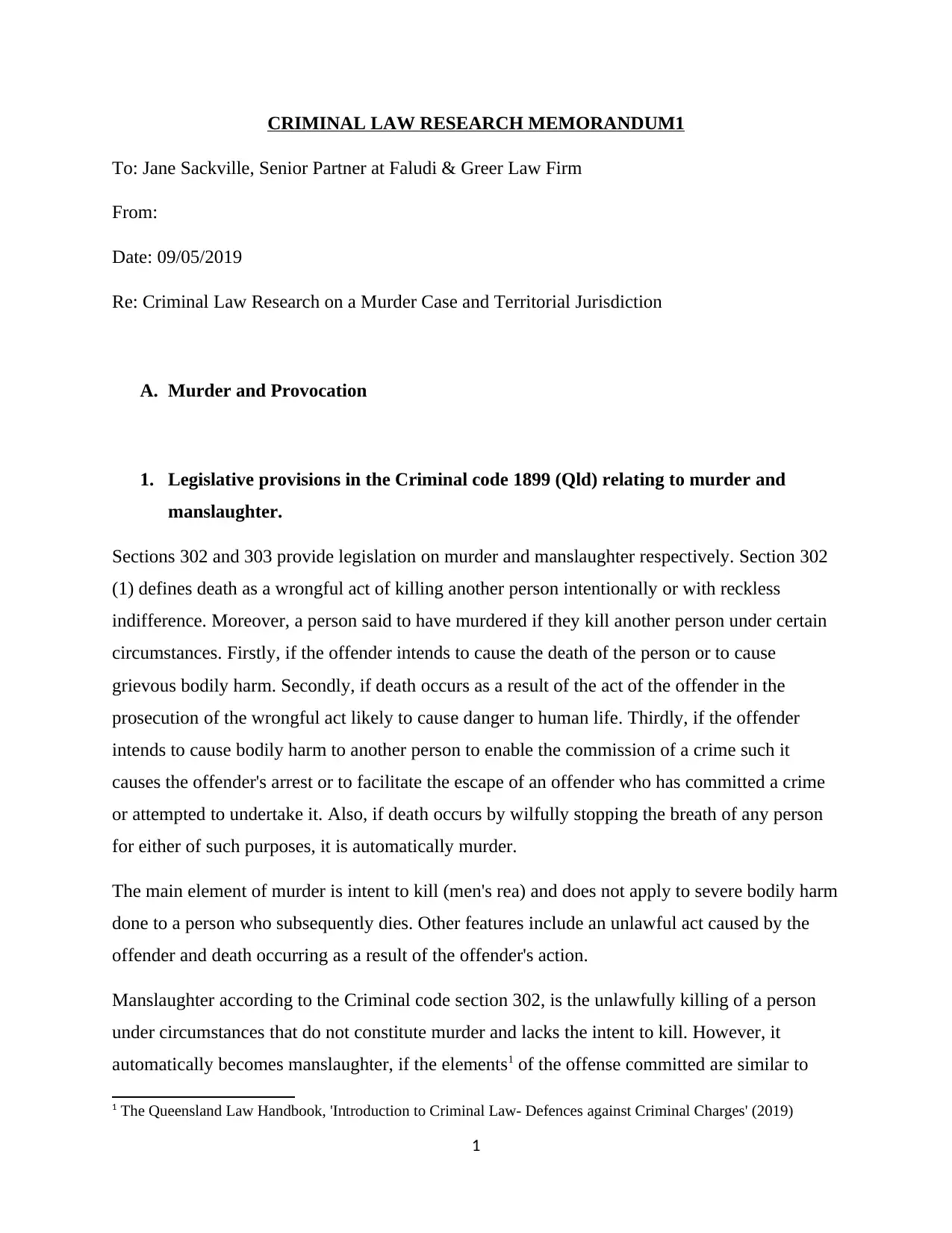
CRIMINAL LAW RESEARCH MEMORANDUM1
To: Jane Sackville, Senior Partner at Faludi & Greer Law Firm
From:
Date: 09/05/2019
Re: Criminal Law Research on a Murder Case and Territorial Jurisdiction
A. Murder and Provocation
1. Legislative provisions in the Criminal code 1899 (Qld) relating to murder and
manslaughter.
Sections 302 and 303 provide legislation on murder and manslaughter respectively. Section 302
(1) defines death as a wrongful act of killing another person intentionally or with reckless
indifference. Moreover, a person said to have murdered if they kill another person under certain
circumstances. Firstly, if the offender intends to cause the death of the person or to cause
grievous bodily harm. Secondly, if death occurs as a result of the act of the offender in the
prosecution of the wrongful act likely to cause danger to human life. Thirdly, if the offender
intends to cause bodily harm to another person to enable the commission of a crime such it
causes the offender's arrest or to facilitate the escape of an offender who has committed a crime
or attempted to undertake it. Also, if death occurs by wilfully stopping the breath of any person
for either of such purposes, it is automatically murder.
The main element of murder is intent to kill (men's rea) and does not apply to severe bodily harm
done to a person who subsequently dies. Other features include an unlawful act caused by the
offender and death occurring as a result of the offender's action.
Manslaughter according to the Criminal code section 302, is the unlawfully killing of a person
under circumstances that do not constitute murder and lacks the intent to kill. However, it
automatically becomes manslaughter, if the elements1 of the offense committed are similar to
1 The Queensland Law Handbook, 'Introduction to Criminal Law- Defences against Criminal Charges' (2019)
1
To: Jane Sackville, Senior Partner at Faludi & Greer Law Firm
From:
Date: 09/05/2019
Re: Criminal Law Research on a Murder Case and Territorial Jurisdiction
A. Murder and Provocation
1. Legislative provisions in the Criminal code 1899 (Qld) relating to murder and
manslaughter.
Sections 302 and 303 provide legislation on murder and manslaughter respectively. Section 302
(1) defines death as a wrongful act of killing another person intentionally or with reckless
indifference. Moreover, a person said to have murdered if they kill another person under certain
circumstances. Firstly, if the offender intends to cause the death of the person or to cause
grievous bodily harm. Secondly, if death occurs as a result of the act of the offender in the
prosecution of the wrongful act likely to cause danger to human life. Thirdly, if the offender
intends to cause bodily harm to another person to enable the commission of a crime such it
causes the offender's arrest or to facilitate the escape of an offender who has committed a crime
or attempted to undertake it. Also, if death occurs by wilfully stopping the breath of any person
for either of such purposes, it is automatically murder.
The main element of murder is intent to kill (men's rea) and does not apply to severe bodily harm
done to a person who subsequently dies. Other features include an unlawful act caused by the
offender and death occurring as a result of the offender's action.
Manslaughter according to the Criminal code section 302, is the unlawfully killing of a person
under circumstances that do not constitute murder and lacks the intent to kill. However, it
automatically becomes manslaughter, if the elements1 of the offense committed are similar to
1 The Queensland Law Handbook, 'Introduction to Criminal Law- Defences against Criminal Charges' (2019)
1
Paraphrase This Document
Need a fresh take? Get an instant paraphrase of this document with our AI Paraphraser
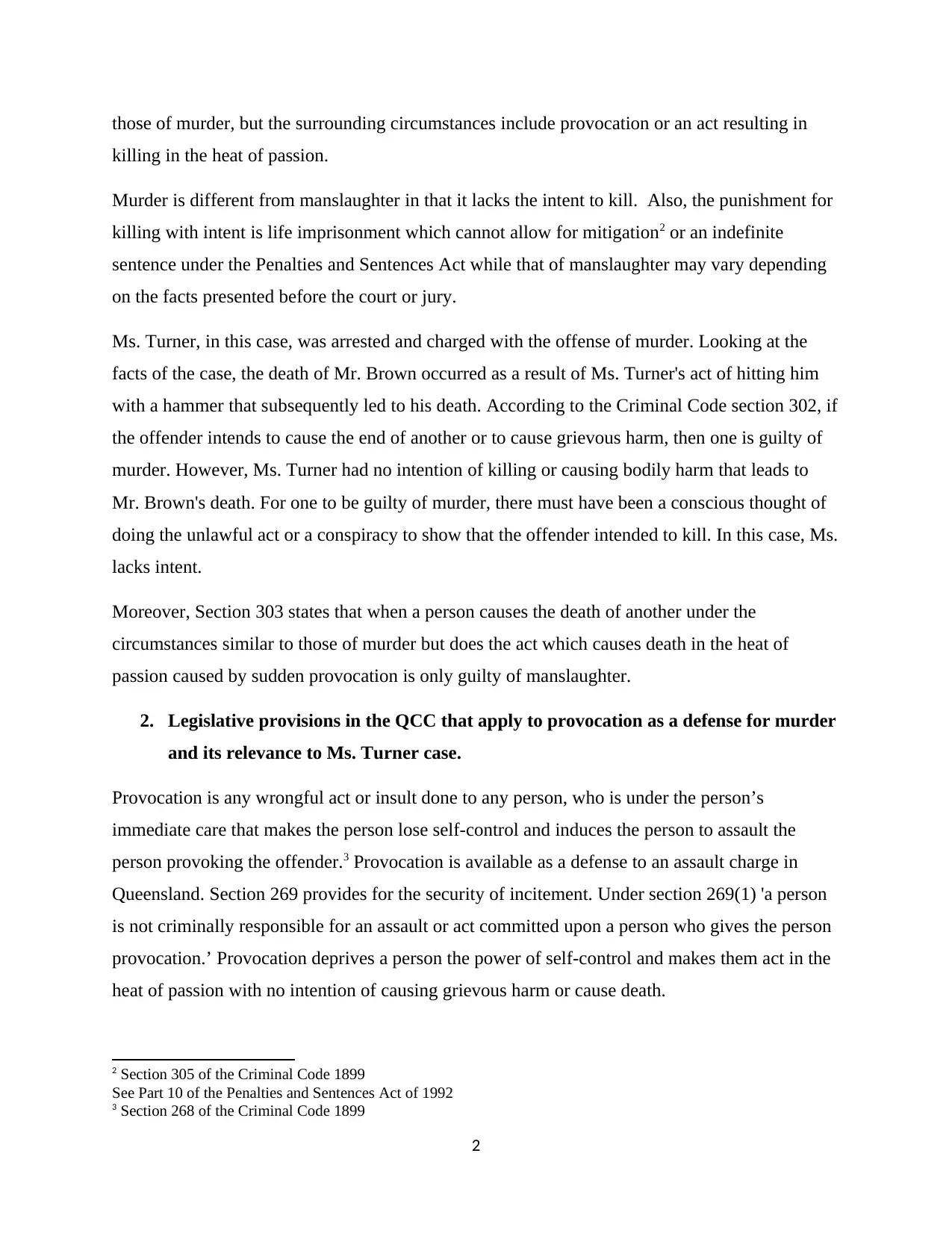
those of murder, but the surrounding circumstances include provocation or an act resulting in
killing in the heat of passion.
Murder is different from manslaughter in that it lacks the intent to kill. Also, the punishment for
killing with intent is life imprisonment which cannot allow for mitigation2 or an indefinite
sentence under the Penalties and Sentences Act while that of manslaughter may vary depending
on the facts presented before the court or jury.
Ms. Turner, in this case, was arrested and charged with the offense of murder. Looking at the
facts of the case, the death of Mr. Brown occurred as a result of Ms. Turner's act of hitting him
with a hammer that subsequently led to his death. According to the Criminal Code section 302, if
the offender intends to cause the end of another or to cause grievous harm, then one is guilty of
murder. However, Ms. Turner had no intention of killing or causing bodily harm that leads to
Mr. Brown's death. For one to be guilty of murder, there must have been a conscious thought of
doing the unlawful act or a conspiracy to show that the offender intended to kill. In this case, Ms.
lacks intent.
Moreover, Section 303 states that when a person causes the death of another under the
circumstances similar to those of murder but does the act which causes death in the heat of
passion caused by sudden provocation is only guilty of manslaughter.
2. Legislative provisions in the QCC that apply to provocation as a defense for murder
and its relevance to Ms. Turner case.
Provocation is any wrongful act or insult done to any person, who is under the person’s
immediate care that makes the person lose self-control and induces the person to assault the
person provoking the offender.3 Provocation is available as a defense to an assault charge in
Queensland. Section 269 provides for the security of incitement. Under section 269(1) 'a person
is not criminally responsible for an assault or act committed upon a person who gives the person
provocation.’ Provocation deprives a person the power of self-control and makes them act in the
heat of passion with no intention of causing grievous harm or cause death.
2 Section 305 of the Criminal Code 1899
See Part 10 of the Penalties and Sentences Act of 1992
3 Section 268 of the Criminal Code 1899
2
killing in the heat of passion.
Murder is different from manslaughter in that it lacks the intent to kill. Also, the punishment for
killing with intent is life imprisonment which cannot allow for mitigation2 or an indefinite
sentence under the Penalties and Sentences Act while that of manslaughter may vary depending
on the facts presented before the court or jury.
Ms. Turner, in this case, was arrested and charged with the offense of murder. Looking at the
facts of the case, the death of Mr. Brown occurred as a result of Ms. Turner's act of hitting him
with a hammer that subsequently led to his death. According to the Criminal Code section 302, if
the offender intends to cause the end of another or to cause grievous harm, then one is guilty of
murder. However, Ms. Turner had no intention of killing or causing bodily harm that leads to
Mr. Brown's death. For one to be guilty of murder, there must have been a conscious thought of
doing the unlawful act or a conspiracy to show that the offender intended to kill. In this case, Ms.
lacks intent.
Moreover, Section 303 states that when a person causes the death of another under the
circumstances similar to those of murder but does the act which causes death in the heat of
passion caused by sudden provocation is only guilty of manslaughter.
2. Legislative provisions in the QCC that apply to provocation as a defense for murder
and its relevance to Ms. Turner case.
Provocation is any wrongful act or insult done to any person, who is under the person’s
immediate care that makes the person lose self-control and induces the person to assault the
person provoking the offender.3 Provocation is available as a defense to an assault charge in
Queensland. Section 269 provides for the security of incitement. Under section 269(1) 'a person
is not criminally responsible for an assault or act committed upon a person who gives the person
provocation.’ Provocation deprives a person the power of self-control and makes them act in the
heat of passion with no intention of causing grievous harm or cause death.
2 Section 305 of the Criminal Code 1899
See Part 10 of the Penalties and Sentences Act of 1992
3 Section 268 of the Criminal Code 1899
2
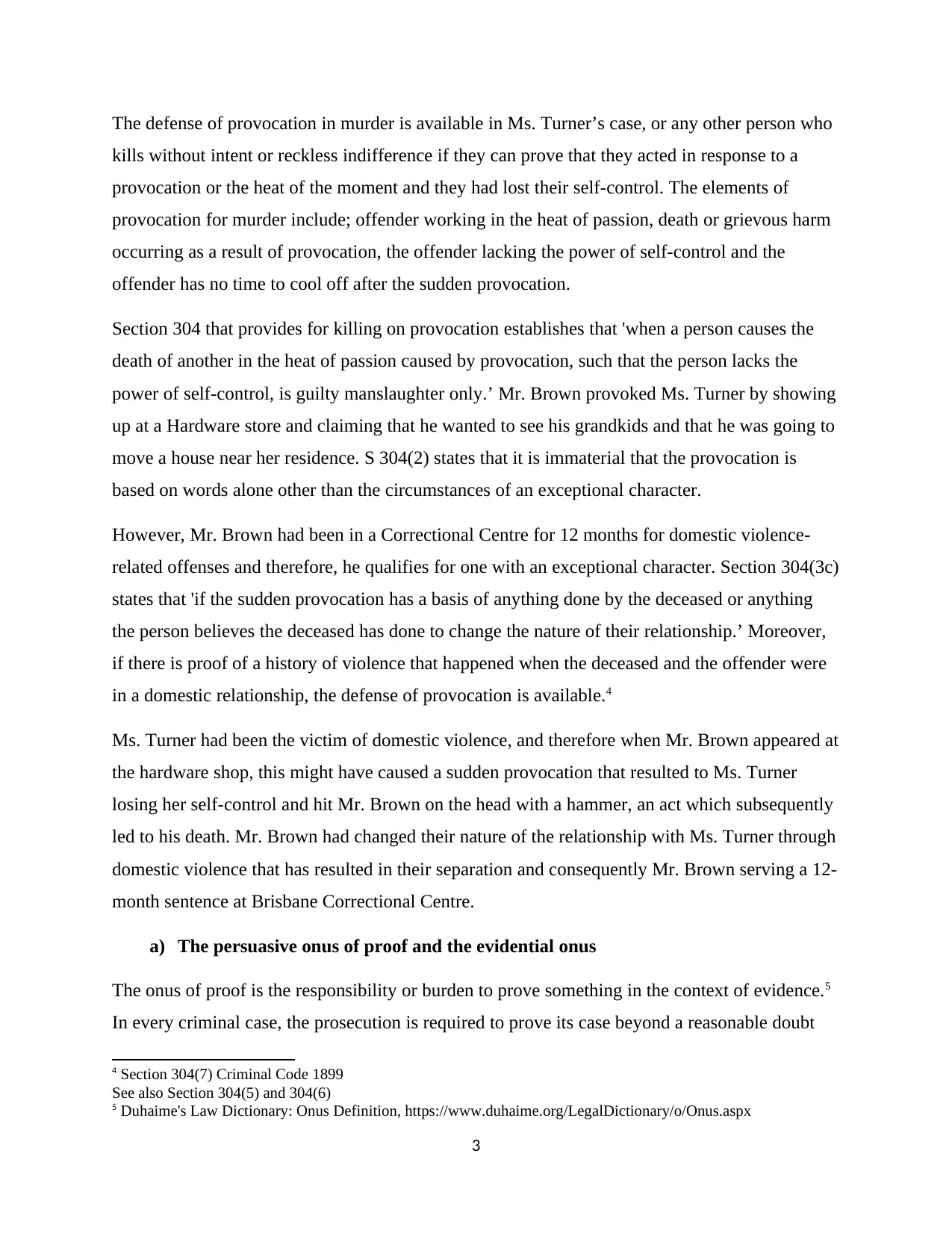
The defense of provocation in murder is available in Ms. Turner’s case, or any other person who
kills without intent or reckless indifference if they can prove that they acted in response to a
provocation or the heat of the moment and they had lost their self-control. The elements of
provocation for murder include; offender working in the heat of passion, death or grievous harm
occurring as a result of provocation, the offender lacking the power of self-control and the
offender has no time to cool off after the sudden provocation.
Section 304 that provides for killing on provocation establishes that 'when a person causes the
death of another in the heat of passion caused by provocation, such that the person lacks the
power of self-control, is guilty manslaughter only.’ Mr. Brown provoked Ms. Turner by showing
up at a Hardware store and claiming that he wanted to see his grandkids and that he was going to
move a house near her residence. S 304(2) states that it is immaterial that the provocation is
based on words alone other than the circumstances of an exceptional character.
However, Mr. Brown had been in a Correctional Centre for 12 months for domestic violence-
related offenses and therefore, he qualifies for one with an exceptional character. Section 304(3c)
states that 'if the sudden provocation has a basis of anything done by the deceased or anything
the person believes the deceased has done to change the nature of their relationship.’ Moreover,
if there is proof of a history of violence that happened when the deceased and the offender were
in a domestic relationship, the defense of provocation is available.4
Ms. Turner had been the victim of domestic violence, and therefore when Mr. Brown appeared at
the hardware shop, this might have caused a sudden provocation that resulted to Ms. Turner
losing her self-control and hit Mr. Brown on the head with a hammer, an act which subsequently
led to his death. Mr. Brown had changed their nature of the relationship with Ms. Turner through
domestic violence that has resulted in their separation and consequently Mr. Brown serving a 12-
month sentence at Brisbane Correctional Centre.
a) The persuasive onus of proof and the evidential onus
The onus of proof is the responsibility or burden to prove something in the context of evidence.5
In every criminal case, the prosecution is required to prove its case beyond a reasonable doubt
4 Section 304(7) Criminal Code 1899
See also Section 304(5) and 304(6)
5 Duhaime's Law Dictionary: Onus Definition, https://www.duhaime.org/LegalDictionary/o/Onus.aspx
3
kills without intent or reckless indifference if they can prove that they acted in response to a
provocation or the heat of the moment and they had lost their self-control. The elements of
provocation for murder include; offender working in the heat of passion, death or grievous harm
occurring as a result of provocation, the offender lacking the power of self-control and the
offender has no time to cool off after the sudden provocation.
Section 304 that provides for killing on provocation establishes that 'when a person causes the
death of another in the heat of passion caused by provocation, such that the person lacks the
power of self-control, is guilty manslaughter only.’ Mr. Brown provoked Ms. Turner by showing
up at a Hardware store and claiming that he wanted to see his grandkids and that he was going to
move a house near her residence. S 304(2) states that it is immaterial that the provocation is
based on words alone other than the circumstances of an exceptional character.
However, Mr. Brown had been in a Correctional Centre for 12 months for domestic violence-
related offenses and therefore, he qualifies for one with an exceptional character. Section 304(3c)
states that 'if the sudden provocation has a basis of anything done by the deceased or anything
the person believes the deceased has done to change the nature of their relationship.’ Moreover,
if there is proof of a history of violence that happened when the deceased and the offender were
in a domestic relationship, the defense of provocation is available.4
Ms. Turner had been the victim of domestic violence, and therefore when Mr. Brown appeared at
the hardware shop, this might have caused a sudden provocation that resulted to Ms. Turner
losing her self-control and hit Mr. Brown on the head with a hammer, an act which subsequently
led to his death. Mr. Brown had changed their nature of the relationship with Ms. Turner through
domestic violence that has resulted in their separation and consequently Mr. Brown serving a 12-
month sentence at Brisbane Correctional Centre.
a) The persuasive onus of proof and the evidential onus
The onus of proof is the responsibility or burden to prove something in the context of evidence.5
In every criminal case, the prosecution is required to prove its case beyond a reasonable doubt
4 Section 304(7) Criminal Code 1899
See also Section 304(5) and 304(6)
5 Duhaime's Law Dictionary: Onus Definition, https://www.duhaime.org/LegalDictionary/o/Onus.aspx
3
⊘ This is a preview!⊘
Do you want full access?
Subscribe today to unlock all pages.

Trusted by 1+ million students worldwide
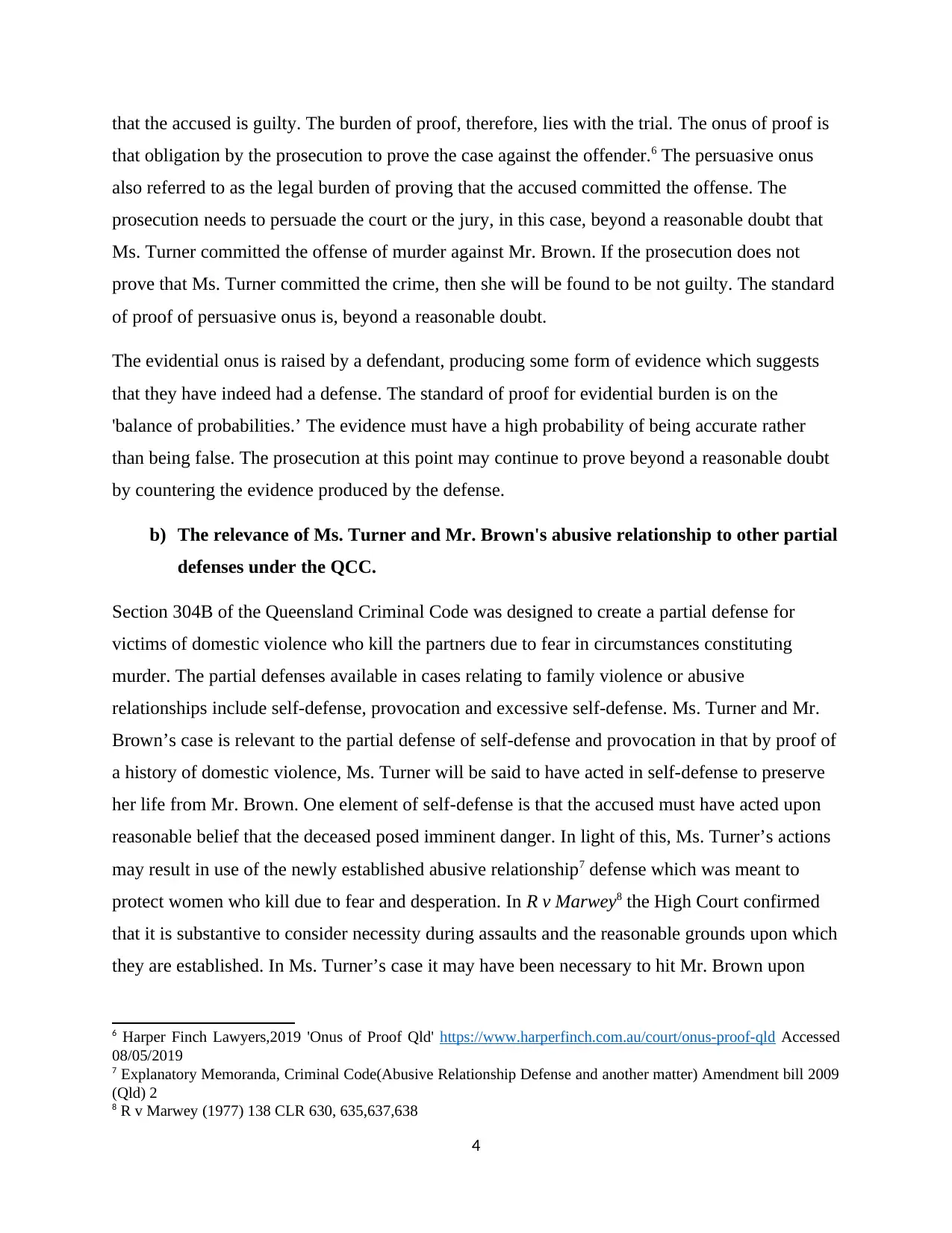
that the accused is guilty. The burden of proof, therefore, lies with the trial. The onus of proof is
that obligation by the prosecution to prove the case against the offender.6 The persuasive onus
also referred to as the legal burden of proving that the accused committed the offense. The
prosecution needs to persuade the court or the jury, in this case, beyond a reasonable doubt that
Ms. Turner committed the offense of murder against Mr. Brown. If the prosecution does not
prove that Ms. Turner committed the crime, then she will be found to be not guilty. The standard
of proof of persuasive onus is, beyond a reasonable doubt.
The evidential onus is raised by a defendant, producing some form of evidence which suggests
that they have indeed had a defense. The standard of proof for evidential burden is on the
'balance of probabilities.’ The evidence must have a high probability of being accurate rather
than being false. The prosecution at this point may continue to prove beyond a reasonable doubt
by countering the evidence produced by the defense.
b) The relevance of Ms. Turner and Mr. Brown's abusive relationship to other partial
defenses under the QCC.
Section 304B of the Queensland Criminal Code was designed to create a partial defense for
victims of domestic violence who kill the partners due to fear in circumstances constituting
murder. The partial defenses available in cases relating to family violence or abusive
relationships include self-defense, provocation and excessive self-defense. Ms. Turner and Mr.
Brown’s case is relevant to the partial defense of self-defense and provocation in that by proof of
a history of domestic violence, Ms. Turner will be said to have acted in self-defense to preserve
her life from Mr. Brown. One element of self-defense is that the accused must have acted upon
reasonable belief that the deceased posed imminent danger. In light of this, Ms. Turner’s actions
may result in use of the newly established abusive relationship7 defense which was meant to
protect women who kill due to fear and desperation. In R v Marwey8 the High Court confirmed
that it is substantive to consider necessity during assaults and the reasonable grounds upon which
they are established. In Ms. Turner’s case it may have been necessary to hit Mr. Brown upon
6 Harper Finch Lawyers,2019 'Onus of Proof Qld' https://www.harperfinch.com.au/court/onus-proof-qld Accessed
08/05/2019
7 Explanatory Memoranda, Criminal Code(Abusive Relationship Defense and another matter) Amendment bill 2009
(Qld) 2
8 R v Marwey (1977) 138 CLR 630, 635,637,638
4
that obligation by the prosecution to prove the case against the offender.6 The persuasive onus
also referred to as the legal burden of proving that the accused committed the offense. The
prosecution needs to persuade the court or the jury, in this case, beyond a reasonable doubt that
Ms. Turner committed the offense of murder against Mr. Brown. If the prosecution does not
prove that Ms. Turner committed the crime, then she will be found to be not guilty. The standard
of proof of persuasive onus is, beyond a reasonable doubt.
The evidential onus is raised by a defendant, producing some form of evidence which suggests
that they have indeed had a defense. The standard of proof for evidential burden is on the
'balance of probabilities.’ The evidence must have a high probability of being accurate rather
than being false. The prosecution at this point may continue to prove beyond a reasonable doubt
by countering the evidence produced by the defense.
b) The relevance of Ms. Turner and Mr. Brown's abusive relationship to other partial
defenses under the QCC.
Section 304B of the Queensland Criminal Code was designed to create a partial defense for
victims of domestic violence who kill the partners due to fear in circumstances constituting
murder. The partial defenses available in cases relating to family violence or abusive
relationships include self-defense, provocation and excessive self-defense. Ms. Turner and Mr.
Brown’s case is relevant to the partial defense of self-defense and provocation in that by proof of
a history of domestic violence, Ms. Turner will be said to have acted in self-defense to preserve
her life from Mr. Brown. One element of self-defense is that the accused must have acted upon
reasonable belief that the deceased posed imminent danger. In light of this, Ms. Turner’s actions
may result in use of the newly established abusive relationship7 defense which was meant to
protect women who kill due to fear and desperation. In R v Marwey8 the High Court confirmed
that it is substantive to consider necessity during assaults and the reasonable grounds upon which
they are established. In Ms. Turner’s case it may have been necessary to hit Mr. Brown upon
6 Harper Finch Lawyers,2019 'Onus of Proof Qld' https://www.harperfinch.com.au/court/onus-proof-qld Accessed
08/05/2019
7 Explanatory Memoranda, Criminal Code(Abusive Relationship Defense and another matter) Amendment bill 2009
(Qld) 2
8 R v Marwey (1977) 138 CLR 630, 635,637,638
4
Paraphrase This Document
Need a fresh take? Get an instant paraphrase of this document with our AI Paraphraser
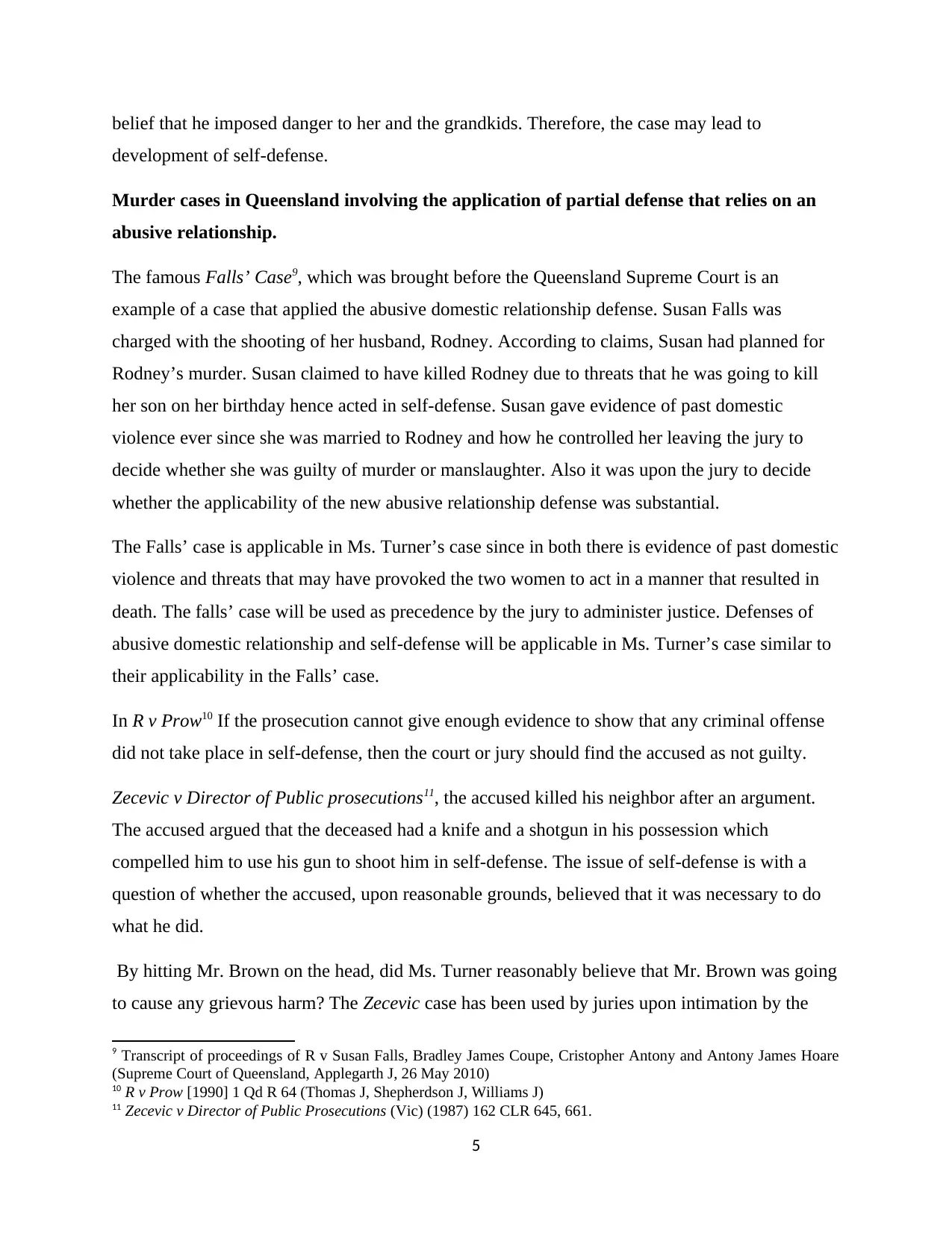
belief that he imposed danger to her and the grandkids. Therefore, the case may lead to
development of self-defense.
Murder cases in Queensland involving the application of partial defense that relies on an
abusive relationship.
The famous Falls’ Case9, which was brought before the Queensland Supreme Court is an
example of a case that applied the abusive domestic relationship defense. Susan Falls was
charged with the shooting of her husband, Rodney. According to claims, Susan had planned for
Rodney’s murder. Susan claimed to have killed Rodney due to threats that he was going to kill
her son on her birthday hence acted in self-defense. Susan gave evidence of past domestic
violence ever since she was married to Rodney and how he controlled her leaving the jury to
decide whether she was guilty of murder or manslaughter. Also it was upon the jury to decide
whether the applicability of the new abusive relationship defense was substantial.
The Falls’ case is applicable in Ms. Turner’s case since in both there is evidence of past domestic
violence and threats that may have provoked the two women to act in a manner that resulted in
death. The falls’ case will be used as precedence by the jury to administer justice. Defenses of
abusive domestic relationship and self-defense will be applicable in Ms. Turner’s case similar to
their applicability in the Falls’ case.
In R v Prow10 If the prosecution cannot give enough evidence to show that any criminal offense
did not take place in self-defense, then the court or jury should find the accused as not guilty.
Zecevic v Director of Public prosecutions11, the accused killed his neighbor after an argument.
The accused argued that the deceased had a knife and a shotgun in his possession which
compelled him to use his gun to shoot him in self-defense. The issue of self-defense is with a
question of whether the accused, upon reasonable grounds, believed that it was necessary to do
what he did.
By hitting Mr. Brown on the head, did Ms. Turner reasonably believe that Mr. Brown was going
to cause any grievous harm? The Zecevic case has been used by juries upon intimation by the
9 Transcript of proceedings of R v Susan Falls, Bradley James Coupe, Cristopher Antony and Antony James Hoare
(Supreme Court of Queensland, Applegarth J, 26 May 2010)
10 R v Prow [1990] 1 Qd R 64 (Thomas J, Shepherdson J, Williams J)
11 Zecevic v Director of Public Prosecutions (Vic) (1987) 162 CLR 645, 661.
5
development of self-defense.
Murder cases in Queensland involving the application of partial defense that relies on an
abusive relationship.
The famous Falls’ Case9, which was brought before the Queensland Supreme Court is an
example of a case that applied the abusive domestic relationship defense. Susan Falls was
charged with the shooting of her husband, Rodney. According to claims, Susan had planned for
Rodney’s murder. Susan claimed to have killed Rodney due to threats that he was going to kill
her son on her birthday hence acted in self-defense. Susan gave evidence of past domestic
violence ever since she was married to Rodney and how he controlled her leaving the jury to
decide whether she was guilty of murder or manslaughter. Also it was upon the jury to decide
whether the applicability of the new abusive relationship defense was substantial.
The Falls’ case is applicable in Ms. Turner’s case since in both there is evidence of past domestic
violence and threats that may have provoked the two women to act in a manner that resulted in
death. The falls’ case will be used as precedence by the jury to administer justice. Defenses of
abusive domestic relationship and self-defense will be applicable in Ms. Turner’s case similar to
their applicability in the Falls’ case.
In R v Prow10 If the prosecution cannot give enough evidence to show that any criminal offense
did not take place in self-defense, then the court or jury should find the accused as not guilty.
Zecevic v Director of Public prosecutions11, the accused killed his neighbor after an argument.
The accused argued that the deceased had a knife and a shotgun in his possession which
compelled him to use his gun to shoot him in self-defense. The issue of self-defense is with a
question of whether the accused, upon reasonable grounds, believed that it was necessary to do
what he did.
By hitting Mr. Brown on the head, did Ms. Turner reasonably believe that Mr. Brown was going
to cause any grievous harm? The Zecevic case has been used by juries upon intimation by the
9 Transcript of proceedings of R v Susan Falls, Bradley James Coupe, Cristopher Antony and Antony James Hoare
(Supreme Court of Queensland, Applegarth J, 26 May 2010)
10 R v Prow [1990] 1 Qd R 64 (Thomas J, Shepherdson J, Williams J)
11 Zecevic v Director of Public Prosecutions (Vic) (1987) 162 CLR 645, 661.
5
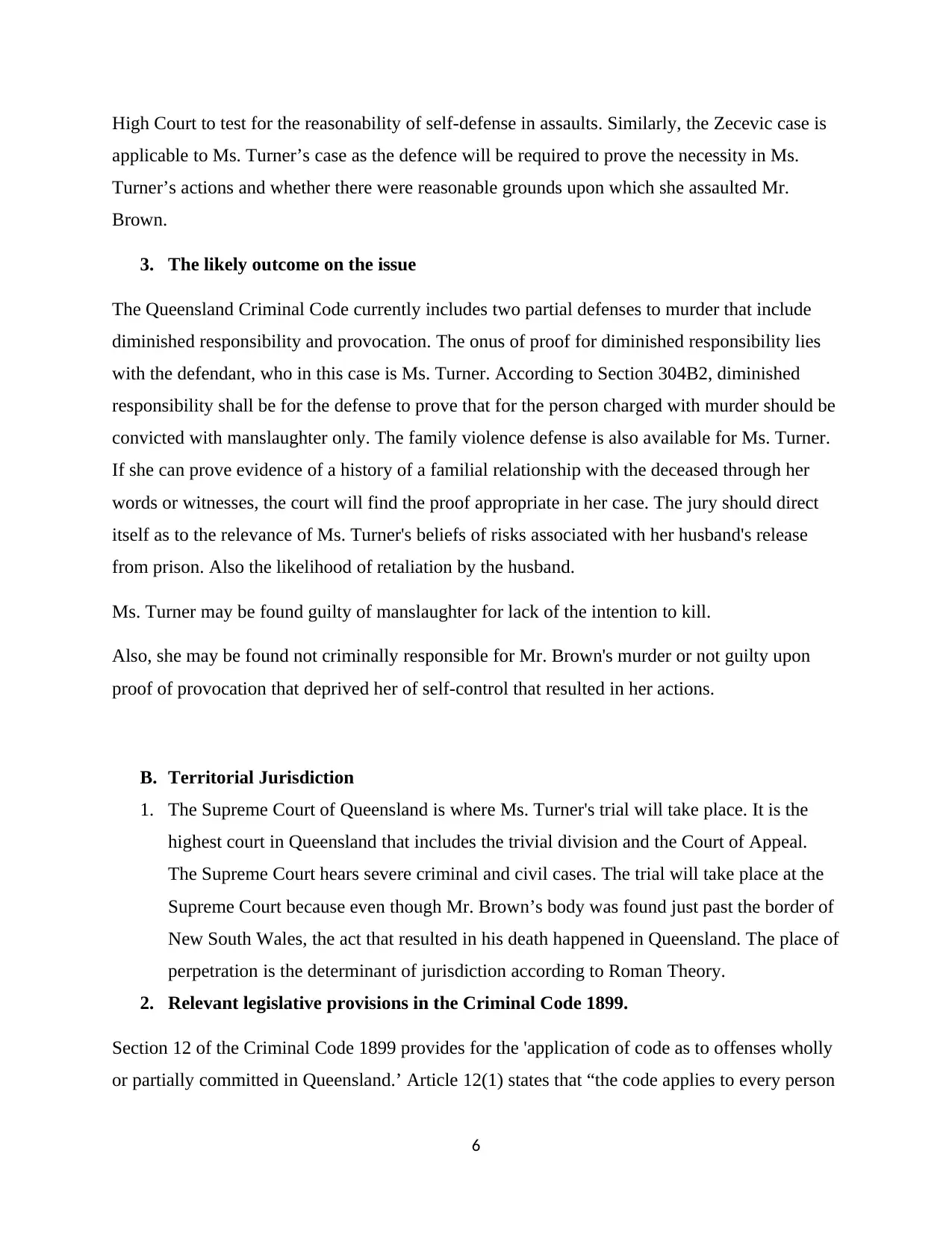
High Court to test for the reasonability of self-defense in assaults. Similarly, the Zecevic case is
applicable to Ms. Turner’s case as the defence will be required to prove the necessity in Ms.
Turner’s actions and whether there were reasonable grounds upon which she assaulted Mr.
Brown.
3. The likely outcome on the issue
The Queensland Criminal Code currently includes two partial defenses to murder that include
diminished responsibility and provocation. The onus of proof for diminished responsibility lies
with the defendant, who in this case is Ms. Turner. According to Section 304B2, diminished
responsibility shall be for the defense to prove that for the person charged with murder should be
convicted with manslaughter only. The family violence defense is also available for Ms. Turner.
If she can prove evidence of a history of a familial relationship with the deceased through her
words or witnesses, the court will find the proof appropriate in her case. The jury should direct
itself as to the relevance of Ms. Turner's beliefs of risks associated with her husband's release
from prison. Also the likelihood of retaliation by the husband.
Ms. Turner may be found guilty of manslaughter for lack of the intention to kill.
Also, she may be found not criminally responsible for Mr. Brown's murder or not guilty upon
proof of provocation that deprived her of self-control that resulted in her actions.
B. Territorial Jurisdiction
1. The Supreme Court of Queensland is where Ms. Turner's trial will take place. It is the
highest court in Queensland that includes the trivial division and the Court of Appeal.
The Supreme Court hears severe criminal and civil cases. The trial will take place at the
Supreme Court because even though Mr. Brown’s body was found just past the border of
New South Wales, the act that resulted in his death happened in Queensland. The place of
perpetration is the determinant of jurisdiction according to Roman Theory.
2. Relevant legislative provisions in the Criminal Code 1899.
Section 12 of the Criminal Code 1899 provides for the 'application of code as to offenses wholly
or partially committed in Queensland.’ Article 12(1) states that “the code applies to every person
6
applicable to Ms. Turner’s case as the defence will be required to prove the necessity in Ms.
Turner’s actions and whether there were reasonable grounds upon which she assaulted Mr.
Brown.
3. The likely outcome on the issue
The Queensland Criminal Code currently includes two partial defenses to murder that include
diminished responsibility and provocation. The onus of proof for diminished responsibility lies
with the defendant, who in this case is Ms. Turner. According to Section 304B2, diminished
responsibility shall be for the defense to prove that for the person charged with murder should be
convicted with manslaughter only. The family violence defense is also available for Ms. Turner.
If she can prove evidence of a history of a familial relationship with the deceased through her
words or witnesses, the court will find the proof appropriate in her case. The jury should direct
itself as to the relevance of Ms. Turner's beliefs of risks associated with her husband's release
from prison. Also the likelihood of retaliation by the husband.
Ms. Turner may be found guilty of manslaughter for lack of the intention to kill.
Also, she may be found not criminally responsible for Mr. Brown's murder or not guilty upon
proof of provocation that deprived her of self-control that resulted in her actions.
B. Territorial Jurisdiction
1. The Supreme Court of Queensland is where Ms. Turner's trial will take place. It is the
highest court in Queensland that includes the trivial division and the Court of Appeal.
The Supreme Court hears severe criminal and civil cases. The trial will take place at the
Supreme Court because even though Mr. Brown’s body was found just past the border of
New South Wales, the act that resulted in his death happened in Queensland. The place of
perpetration is the determinant of jurisdiction according to Roman Theory.
2. Relevant legislative provisions in the Criminal Code 1899.
Section 12 of the Criminal Code 1899 provides for the 'application of code as to offenses wholly
or partially committed in Queensland.’ Article 12(1) states that “the code applies to every person
6
⊘ This is a preview!⊘
Do you want full access?
Subscribe today to unlock all pages.

Trusted by 1+ million students worldwide
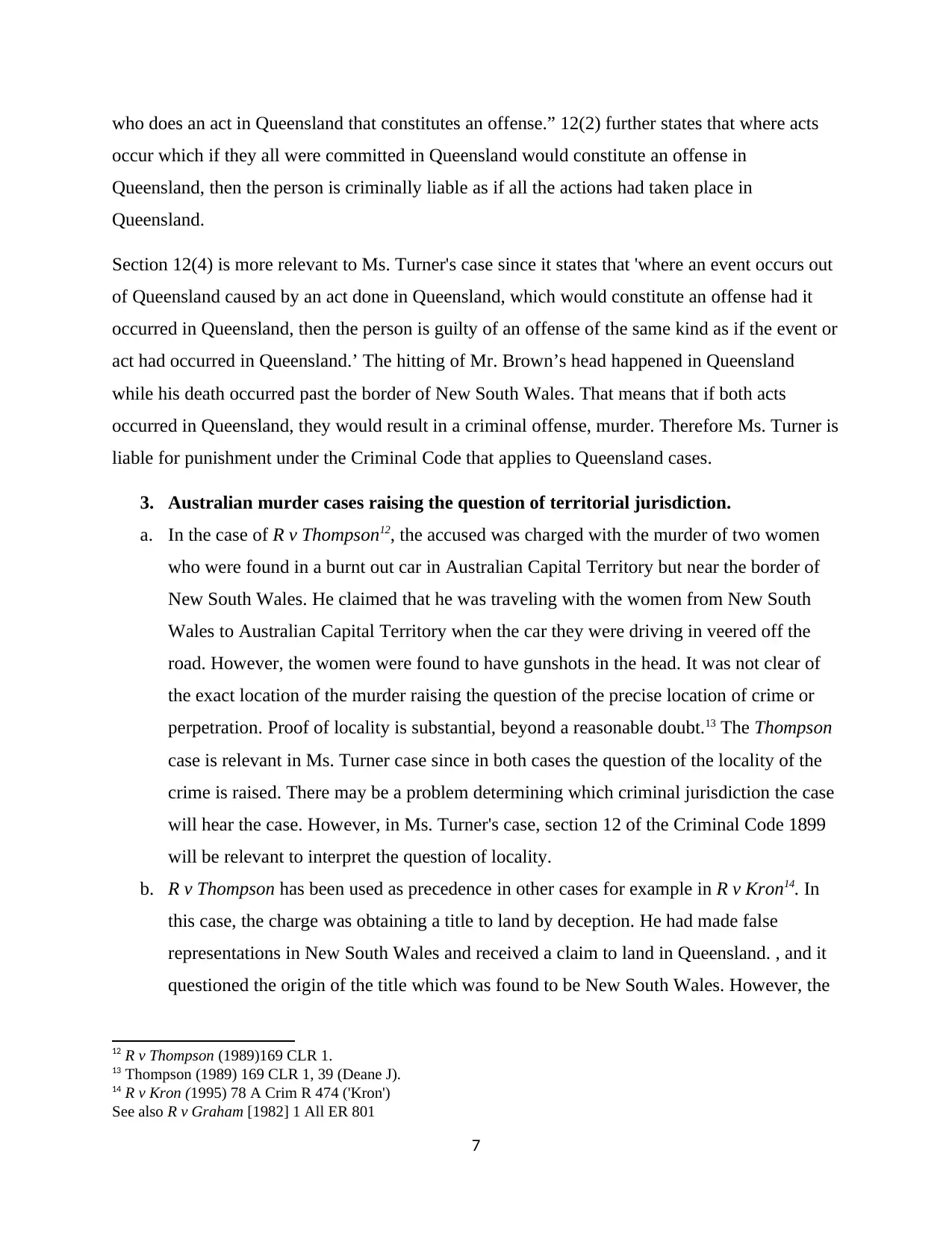
who does an act in Queensland that constitutes an offense.” 12(2) further states that where acts
occur which if they all were committed in Queensland would constitute an offense in
Queensland, then the person is criminally liable as if all the actions had taken place in
Queensland.
Section 12(4) is more relevant to Ms. Turner's case since it states that 'where an event occurs out
of Queensland caused by an act done in Queensland, which would constitute an offense had it
occurred in Queensland, then the person is guilty of an offense of the same kind as if the event or
act had occurred in Queensland.’ The hitting of Mr. Brown’s head happened in Queensland
while his death occurred past the border of New South Wales. That means that if both acts
occurred in Queensland, they would result in a criminal offense, murder. Therefore Ms. Turner is
liable for punishment under the Criminal Code that applies to Queensland cases.
3. Australian murder cases raising the question of territorial jurisdiction.
a. In the case of R v Thompson12, the accused was charged with the murder of two women
who were found in a burnt out car in Australian Capital Territory but near the border of
New South Wales. He claimed that he was traveling with the women from New South
Wales to Australian Capital Territory when the car they were driving in veered off the
road. However, the women were found to have gunshots in the head. It was not clear of
the exact location of the murder raising the question of the precise location of crime or
perpetration. Proof of locality is substantial, beyond a reasonable doubt.13 The Thompson
case is relevant in Ms. Turner case since in both cases the question of the locality of the
crime is raised. There may be a problem determining which criminal jurisdiction the case
will hear the case. However, in Ms. Turner's case, section 12 of the Criminal Code 1899
will be relevant to interpret the question of locality.
b. R v Thompson has been used as precedence in other cases for example in R v Kron14. In
this case, the charge was obtaining a title to land by deception. He had made false
representations in New South Wales and received a claim to land in Queensland. , and it
questioned the origin of the title which was found to be New South Wales. However, the
12 R v Thompson (1989)169 CLR 1.
13 Thompson (1989) 169 CLR 1, 39 (Deane J).
14 R v Kron (1995) 78 A Crim R 474 ('Kron')
See also R v Graham [1982] 1 All ER 801
7
occur which if they all were committed in Queensland would constitute an offense in
Queensland, then the person is criminally liable as if all the actions had taken place in
Queensland.
Section 12(4) is more relevant to Ms. Turner's case since it states that 'where an event occurs out
of Queensland caused by an act done in Queensland, which would constitute an offense had it
occurred in Queensland, then the person is guilty of an offense of the same kind as if the event or
act had occurred in Queensland.’ The hitting of Mr. Brown’s head happened in Queensland
while his death occurred past the border of New South Wales. That means that if both acts
occurred in Queensland, they would result in a criminal offense, murder. Therefore Ms. Turner is
liable for punishment under the Criminal Code that applies to Queensland cases.
3. Australian murder cases raising the question of territorial jurisdiction.
a. In the case of R v Thompson12, the accused was charged with the murder of two women
who were found in a burnt out car in Australian Capital Territory but near the border of
New South Wales. He claimed that he was traveling with the women from New South
Wales to Australian Capital Territory when the car they were driving in veered off the
road. However, the women were found to have gunshots in the head. It was not clear of
the exact location of the murder raising the question of the precise location of crime or
perpetration. Proof of locality is substantial, beyond a reasonable doubt.13 The Thompson
case is relevant in Ms. Turner case since in both cases the question of the locality of the
crime is raised. There may be a problem determining which criminal jurisdiction the case
will hear the case. However, in Ms. Turner's case, section 12 of the Criminal Code 1899
will be relevant to interpret the question of locality.
b. R v Thompson has been used as precedence in other cases for example in R v Kron14. In
this case, the charge was obtaining a title to land by deception. He had made false
representations in New South Wales and received a claim to land in Queensland. , and it
questioned the origin of the title which was found to be New South Wales. However, the
12 R v Thompson (1989)169 CLR 1.
13 Thompson (1989) 169 CLR 1, 39 (Deane J).
14 R v Kron (1995) 78 A Crim R 474 ('Kron')
See also R v Graham [1982] 1 All ER 801
7
Paraphrase This Document
Need a fresh take? Get an instant paraphrase of this document with our AI Paraphraser
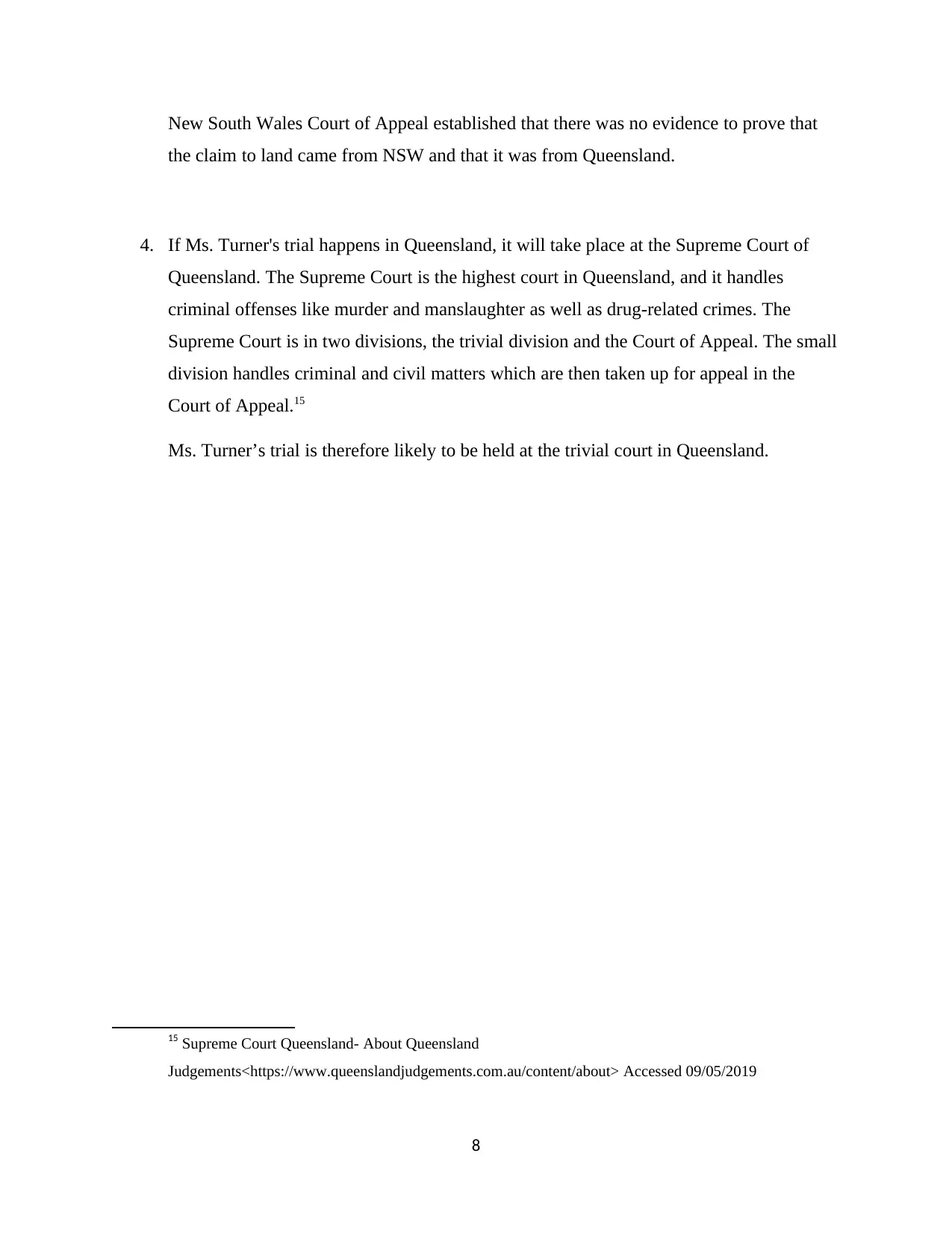
New South Wales Court of Appeal established that there was no evidence to prove that
the claim to land came from NSW and that it was from Queensland.
4. If Ms. Turner's trial happens in Queensland, it will take place at the Supreme Court of
Queensland. The Supreme Court is the highest court in Queensland, and it handles
criminal offenses like murder and manslaughter as well as drug-related crimes. The
Supreme Court is in two divisions, the trivial division and the Court of Appeal. The small
division handles criminal and civil matters which are then taken up for appeal in the
Court of Appeal.15
Ms. Turner’s trial is therefore likely to be held at the trivial court in Queensland.
15 Supreme Court Queensland- About Queensland
Judgements<https://www.queenslandjudgements.com.au/content/about> Accessed 09/05/2019
8
the claim to land came from NSW and that it was from Queensland.
4. If Ms. Turner's trial happens in Queensland, it will take place at the Supreme Court of
Queensland. The Supreme Court is the highest court in Queensland, and it handles
criminal offenses like murder and manslaughter as well as drug-related crimes. The
Supreme Court is in two divisions, the trivial division and the Court of Appeal. The small
division handles criminal and civil matters which are then taken up for appeal in the
Court of Appeal.15
Ms. Turner’s trial is therefore likely to be held at the trivial court in Queensland.
15 Supreme Court Queensland- About Queensland
Judgements<https://www.queenslandjudgements.com.au/content/about> Accessed 09/05/2019
8
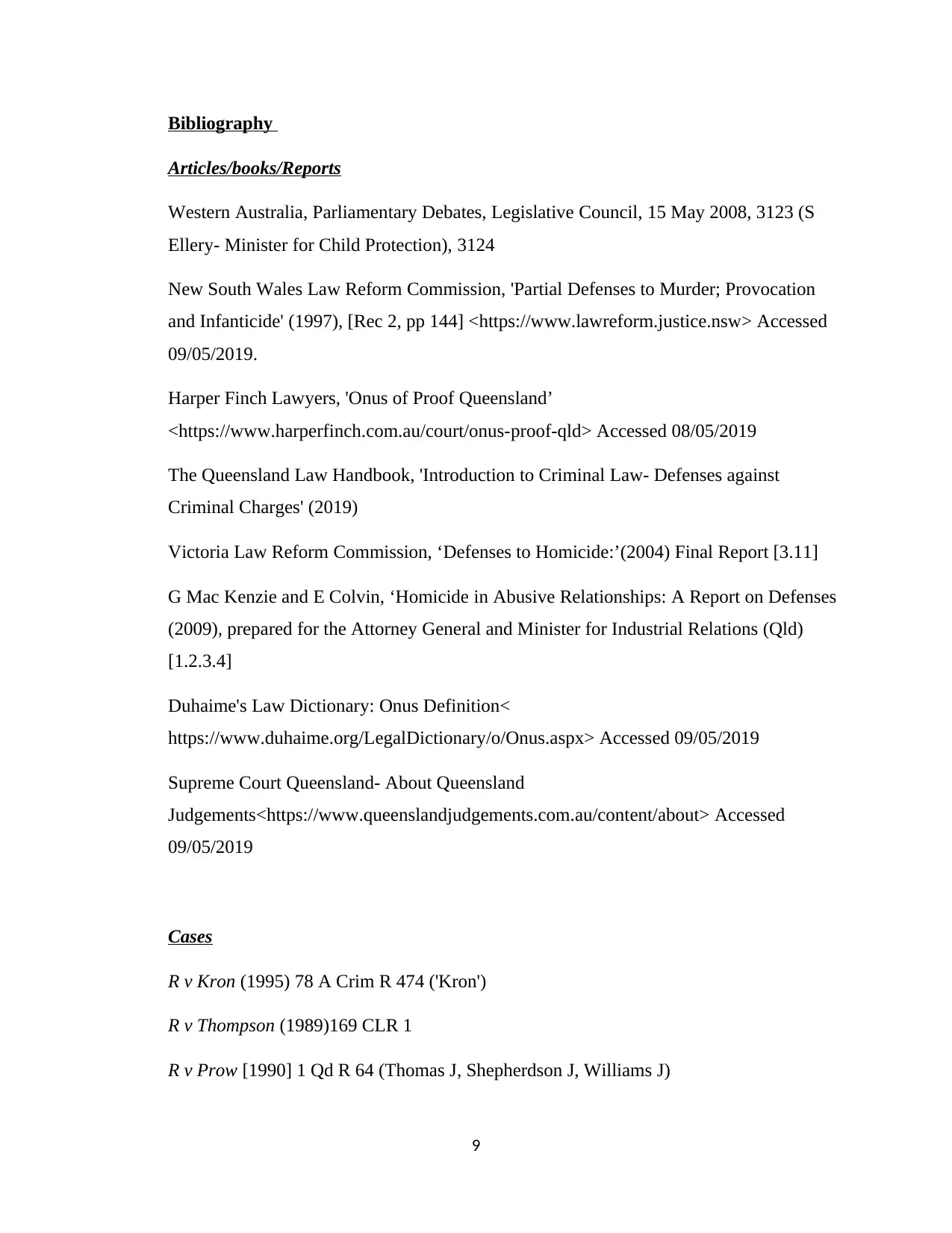
Bibliography
Articles/books/Reports
Western Australia, Parliamentary Debates, Legislative Council, 15 May 2008, 3123 (S
Ellery- Minister for Child Protection), 3124
New South Wales Law Reform Commission, 'Partial Defenses to Murder; Provocation
and Infanticide' (1997), [Rec 2, pp 144] <https://www.lawreform.justice.nsw> Accessed
09/05/2019.
Harper Finch Lawyers, 'Onus of Proof Queensland’
<https://www.harperfinch.com.au/court/onus-proof-qld> Accessed 08/05/2019
The Queensland Law Handbook, 'Introduction to Criminal Law- Defenses against
Criminal Charges' (2019)
Victoria Law Reform Commission, ‘Defenses to Homicide:’(2004) Final Report [3.11]
G Mac Kenzie and E Colvin, ‘Homicide in Abusive Relationships: A Report on Defenses
(2009), prepared for the Attorney General and Minister for Industrial Relations (Qld)
[1.2.3.4]
Duhaime's Law Dictionary: Onus Definition<
https://www.duhaime.org/LegalDictionary/o/Onus.aspx> Accessed 09/05/2019
Supreme Court Queensland- About Queensland
Judgements<https://www.queenslandjudgements.com.au/content/about> Accessed
09/05/2019
Cases
R v Kron (1995) 78 A Crim R 474 ('Kron')
R v Thompson (1989)169 CLR 1
R v Prow [1990] 1 Qd R 64 (Thomas J, Shepherdson J, Williams J)
9
Articles/books/Reports
Western Australia, Parliamentary Debates, Legislative Council, 15 May 2008, 3123 (S
Ellery- Minister for Child Protection), 3124
New South Wales Law Reform Commission, 'Partial Defenses to Murder; Provocation
and Infanticide' (1997), [Rec 2, pp 144] <https://www.lawreform.justice.nsw> Accessed
09/05/2019.
Harper Finch Lawyers, 'Onus of Proof Queensland’
<https://www.harperfinch.com.au/court/onus-proof-qld> Accessed 08/05/2019
The Queensland Law Handbook, 'Introduction to Criminal Law- Defenses against
Criminal Charges' (2019)
Victoria Law Reform Commission, ‘Defenses to Homicide:’(2004) Final Report [3.11]
G Mac Kenzie and E Colvin, ‘Homicide in Abusive Relationships: A Report on Defenses
(2009), prepared for the Attorney General and Minister for Industrial Relations (Qld)
[1.2.3.4]
Duhaime's Law Dictionary: Onus Definition<
https://www.duhaime.org/LegalDictionary/o/Onus.aspx> Accessed 09/05/2019
Supreme Court Queensland- About Queensland
Judgements<https://www.queenslandjudgements.com.au/content/about> Accessed
09/05/2019
Cases
R v Kron (1995) 78 A Crim R 474 ('Kron')
R v Thompson (1989)169 CLR 1
R v Prow [1990] 1 Qd R 64 (Thomas J, Shepherdson J, Williams J)
9
⊘ This is a preview!⊘
Do you want full access?
Subscribe today to unlock all pages.

Trusted by 1+ million students worldwide
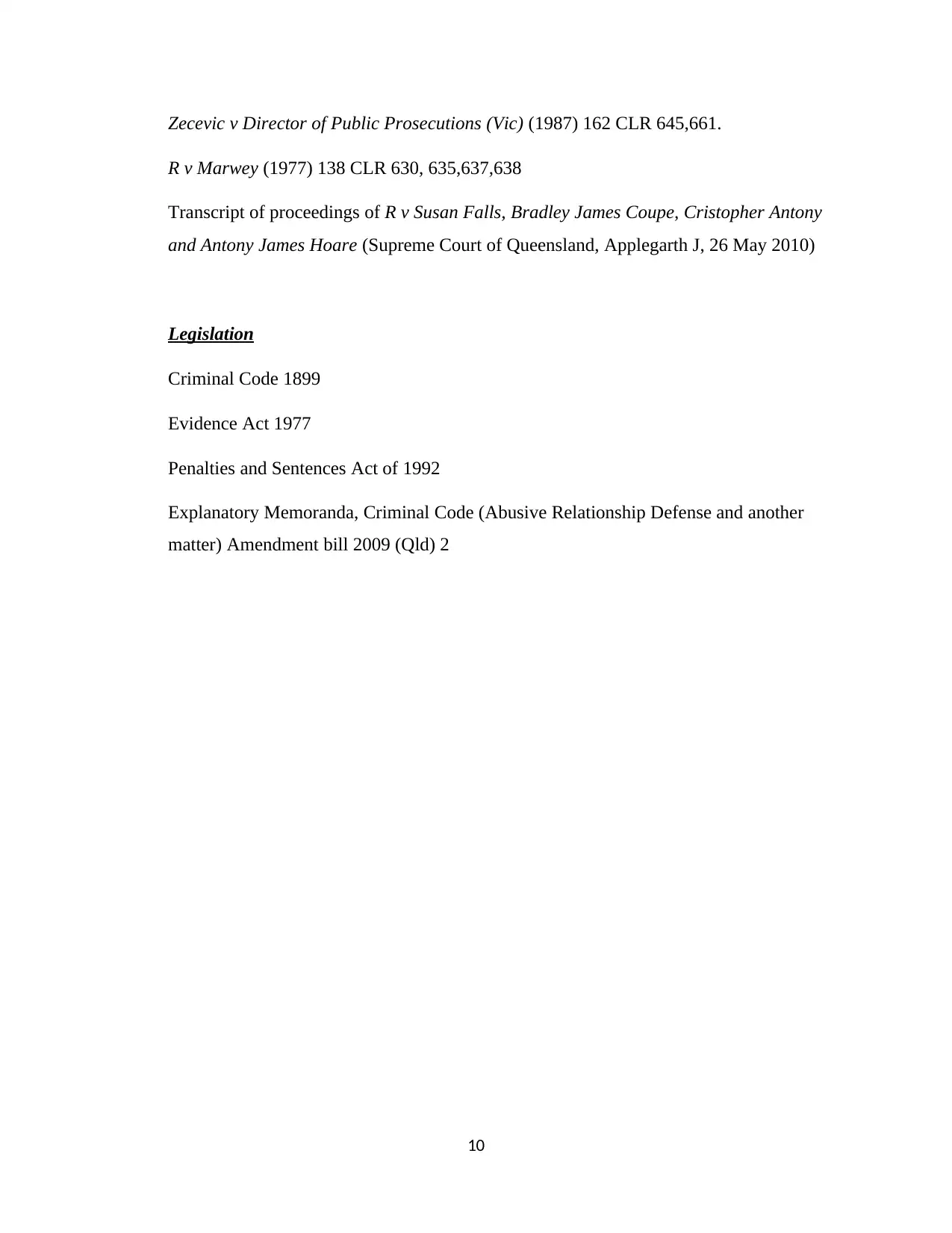
Zecevic v Director of Public Prosecutions (Vic) (1987) 162 CLR 645,661.
R v Marwey (1977) 138 CLR 630, 635,637,638
Transcript of proceedings of R v Susan Falls, Bradley James Coupe, Cristopher Antony
and Antony James Hoare (Supreme Court of Queensland, Applegarth J, 26 May 2010)
Legislation
Criminal Code 1899
Evidence Act 1977
Penalties and Sentences Act of 1992
Explanatory Memoranda, Criminal Code (Abusive Relationship Defense and another
matter) Amendment bill 2009 (Qld) 2
10
R v Marwey (1977) 138 CLR 630, 635,637,638
Transcript of proceedings of R v Susan Falls, Bradley James Coupe, Cristopher Antony
and Antony James Hoare (Supreme Court of Queensland, Applegarth J, 26 May 2010)
Legislation
Criminal Code 1899
Evidence Act 1977
Penalties and Sentences Act of 1992
Explanatory Memoranda, Criminal Code (Abusive Relationship Defense and another
matter) Amendment bill 2009 (Qld) 2
10
1 out of 10
Related Documents
Your All-in-One AI-Powered Toolkit for Academic Success.
+13062052269
info@desklib.com
Available 24*7 on WhatsApp / Email
![[object Object]](/_next/static/media/star-bottom.7253800d.svg)
Unlock your academic potential
Copyright © 2020–2025 A2Z Services. All Rights Reserved. Developed and managed by ZUCOL.





